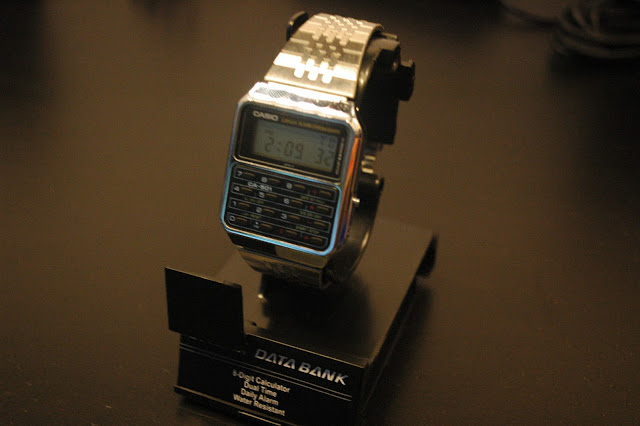I think it's safe to say that I'm in love with Casio
Here's a little background.
After WWII, Japan was able to rebuild and many new companies sprouted from the ashes. One of these companies was Casio, in 1946.
Their first invention was a ring that could hold a cigarette.
After the success from the yubiwa pipe, the company used the profits to make a calculator that worked with solenoids instead of hand crank gears. The calculator had a single keypad (instead of a full keypad)
and a single screen to display instead of three. This is basically what your modern day calculator looks like: you can thank Casio.
After that they built a bunch of other electronics like keyboards, PDAs, clocks, printers, etc etc and watches.
AND WATCHES.
I admire Casio for their true talent for their feats in electrical engineering. I'm a big fan of low level programming and not a huge fan of higher level things like Computer Science, so I really admire Casio for the cute gadgets that they make.
I also appreciate most of old technology, and watches, and 80s fashion. I stumbled upon an old Casio catalog
http://www.angelfire.com/80s/ron28/casio/index1.html
Nostalgia.
Scroll down and you'll find the CA-501.
I've been looking for a calculator watch for along time with certain features
- Solid single module (as compared to a Casio DBC610A, which you can see is sort of two parted)
- Flat band (this is very native to the 1980s. Look at Gerald Genta's design for the royal oak and other watches designed in the 80s. Flat bands are hard to find these days)
- Full metal
- Water resistant
And I stumbled upon the CA-501.
What a beauty.
Most of these watches are extremely damaged from wear and time. You can purchase a scratched up and beaten CA-501 for about $75 on eBay.
I really wanted one.
So I bought one for $30.
As you can see the watch doesn't work. The module itself is damaged.
While the module was damaged there were no signs of wear on the watch at all. No scratches, no stretch on the band.
I love the flat link band.
CA-501
In the past I have had experience with Casio watches. There are multiple models of watches but certain models can share the same electronic module on the inside.
What does that mean?
This watch, according to the 1984 catalog, uses the Module No. 437. I just need to obtain a working module and replace it in this watch, and I will have a CA-501 in almost brand new condition.
I'm not sure how valuable the watch would be, but probably greater than $75.
This is the CA-53, a calculator watch you can buy for $15 at your local Walmart.
The beauty of this is that if any parts break, or buttons get lost on the CA-501, most of them are interchangeable with teh CA-53
The bottom
First step of switching modules is removing the back cover. The CA-501 has an interesting case. I needed to remove the bands before I could remove the back.
I used a flathead screwdrived to pry open the case
The back cover is clip on...
The broken module, with battery removed.
Gently pry out the module.
Open up the CA-53 to access the working module.
A tiny comparison of the modules. The CA-53 seems to use a more updated module.
However both are 437 modules. They will fit if we switch them.
This is surgery.
The new module is inserted
Something you might notice different is that the modules seem to be flipped... You can notice some features on each module that seem like they're mirror images. This created a bit of the problem. The piezo buzzer was in the wrong place now.
As you can see on the CA-53, the buzzer is usually on the bottom of the caseback.
On the CA-501 the buzzer was on the top of the caseback.
Whatever, just rotate it 180.
And snap the case back on! Of course it's upside down now, but it works. No one will ever see under a watch.
It's alive!
A beautiful functioning CA-501.
Have fun!




























